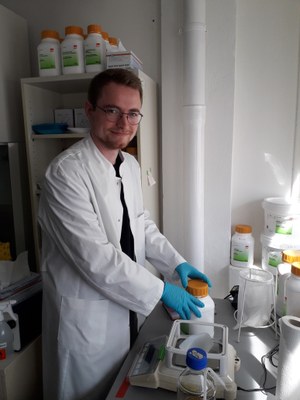Enrico Schiewer
|
|
Room: 003 Email: enrico.schiewer@hu-berlin.de Tel: (030) 2093 98282 |
Krokinobacter eikastus rhodopsin 2 (KR2), as the first discovered light-driven outward Na+ pump, is considered to become part of interesting optogenetic tools. Recent electrophysiological experiments suggest single mutations establishing K+ pumping activity, but the resulting pumping efficiency and ion selectivity under physiological conditions remain unsatisfactory.
My work focusses on analyzing and characterizing those mutants in silico to pave the way for an in vitro optimized KR2 species that functions as a light-gated K+ channel. Combining powerful computational tools like quantum chemistry, classical molecular dynamics simulation and Karlsberg2+ for electrostatics with directed enzyme evolution and electrophysiological analysis will not only help to further investigate the cation translocation mechanism of KR2 in general. Most importantly, it will provide an improved way to shape its ion selectivity.
This work is funded by the European Union's Horizon 2020 research and innovation programme as part of the STARDUST project: https://www.project-stardust.eu/
References:
- Inoue, K. et al. (2013) A light-driven sodium ion pump in marine bacteria. Nat. Commun. 4, 1678.
- Gushchin, I. et al. (2015) Crystal structure of a light-driven sodium pump. Nat. Struct. Mol. Biol. 22, 390–395.
- Kato, H. E. et al. Structural basis for Na(+) transport mechanism by a light-driven Na(+) pump. Nature 521, 48–53 (2015).
- Kaila, V. R. I. et al. (2017) Energetics and dynamics of a light-driven sodium-pumping rhodopsin. Proc. Natl. Acad. Sci. U. S. A. 27, 7043-7048
- Kandori, H., Inoue, K., & Tsunoda, S. P. (2018). Light-Driven Sodium-Pumping Rhodopsin: A New Concept of Active Transport. Chemical Reviews, acs.chemrev.7b00548. https://doi.org/10.1021/acs.chemrev.7b00548
